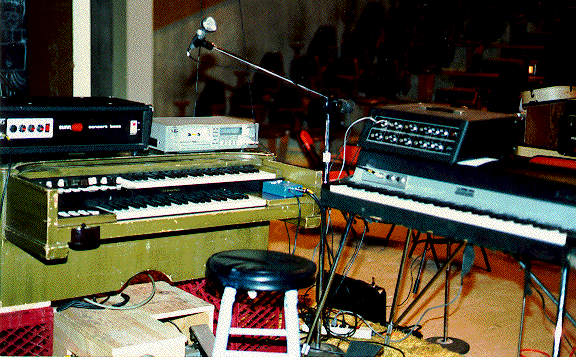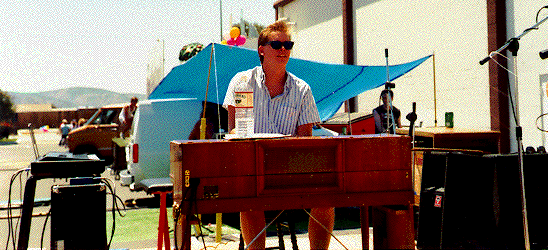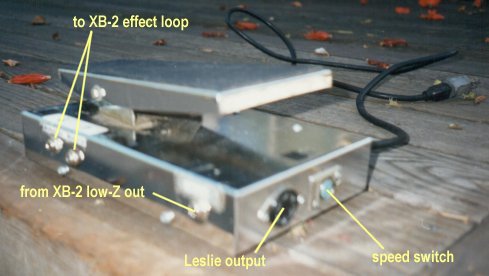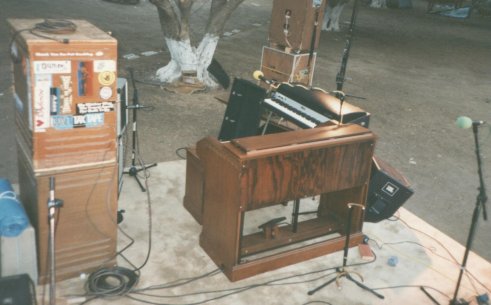













|
updated: 01 Nov 2005
Music's Most Glorious Voice
 Yeah, I have a Hammond now, but that was kind of the end of the journey, not the beginning.
The beginning starts in my parents livingroom, where the organ I grew up playing - a Yamaha Electone E-3 - still sits.
I mainly played liturgical stuff (which I hated), Bach (which I loved) and cheesy shit like
Sweet Georgia Brown and Ethel Smith's Tico Tico, which was a lot of fun. But cheesy. And
Stairway to Heaven, which I bought the sheet music for and figured out how to do some of
the guitar parts on the organ. But, really, I was never very good or motivated, and eventually
I quit when I was in high school.
In college, when I first got serious about playing rock and roll, I bought a Korg Lambda and
a Baldwin Orgasonic under the grossly mistaken assumption that these were rock-and-roll
instruments. Nothing could be further from the truth. Hey, I was young, I had no money,
and it's pretty slim pickens down at the bottom. Or, maybe I just wasn't the brightest bulb on the
tree, but for whatever reason, in my quest for that Rock and Roll Organ sound it took
me awhile to get to the Hammond organ. Which is weird, because I remember when I was a kid
taking organ lessons, two of my instructors had Hammonds.
Yeah, I have a Hammond now, but that was kind of the end of the journey, not the beginning.
The beginning starts in my parents livingroom, where the organ I grew up playing - a Yamaha Electone E-3 - still sits.
I mainly played liturgical stuff (which I hated), Bach (which I loved) and cheesy shit like
Sweet Georgia Brown and Ethel Smith's Tico Tico, which was a lot of fun. But cheesy. And
Stairway to Heaven, which I bought the sheet music for and figured out how to do some of
the guitar parts on the organ. But, really, I was never very good or motivated, and eventually
I quit when I was in high school.
In college, when I first got serious about playing rock and roll, I bought a Korg Lambda and
a Baldwin Orgasonic under the grossly mistaken assumption that these were rock-and-roll
instruments. Nothing could be further from the truth. Hey, I was young, I had no money,
and it's pretty slim pickens down at the bottom. Or, maybe I just wasn't the brightest bulb on the
tree, but for whatever reason, in my quest for that Rock and Roll Organ sound it took
me awhile to get to the Hammond organ. Which is weird, because I remember when I was a kid
taking organ lessons, two of my instructors had Hammonds.
Anyway, at some point I eventually put two and two together and bought my first Hammond. Found it in
the paper for I think $180. It was a snot-green M-3 and came with a Leslie 825. This would have
been in about 1986 or 1987. The 825 is a solid-state
Leslie with a single 12" driver and foam rotor. It came out during the Dark Times (CBS ownership), and
needless to say, it was not Leslie's finest effort.
At some point I got real ambitious and decided to portabilize the M-3, and I did not let the
lack of power tools deter me. Seriously, I had a drill and a handsaw
and a soldering iron and just went at it. So, I sawed it in half and used two milk-crates for a stand. I
built a box to house the amplifier and expression pedal. Went to Industrial Liquidaters, bought the
biggest multi-pin connector I could afford, and made a weird plug harness to
connect the little amp coffin with the rest of the organ. Somehow I did get it
all to work, but it was a very strange setup. I used it for a couple years. After I bought my second M-3
I sold this one to a guy in a reggae band. I never heard from him again, so I hope
everything worked out. I have this fear I will find it at a garage sale someday and feel compelled to buy it back.
The second M-3 also came out of the paper. This one has been
portabilized by the previous owner, and he did a much better job
than I did. He had the good sense to use as much of the original cabinetwork as possible. He moved the
generator shelf up about three inches, and then hung the preamp upside from the top of the
 organ. The original sides of the cabinet were held on with a combination of chest latches and
support bars, kind of like the legs on a Rhodes. It was a little cumbersome to set up, but it was
fairly compact and looked and sounded great. Actually, the sound was a huge improvement
because this M-3 came with a Leslie 145. It was like night and day. I played this Hammond for
several years.
organ. The original sides of the cabinet were held on with a combination of chest latches and
support bars, kind of like the legs on a Rhodes. It was a little cumbersome to set up, but it was
fairly compact and looked and sounded great. Actually, the sound was a huge improvement
because this M-3 came with a Leslie 145. It was like night and day. I played this Hammond for
several years.
By this time I was out of school and I actually had an income. My first big purchase
was a Korg SG-1D sampled grand piano. I also started trying to find a more portable way to get
that Hammond sound. I was in Syracuse NY on business and saw a very rare Korg BX-3
for sale in the local paper.
The BX-3 had achieved almost legendary status and was/is all but impossible to find. This one
was in excellent condition and it came with a flight case. I ruminated on this
purchase for a few weeks after returning home to San Diego, and then decided to send the money ($1200!)
to my friend Andy, who drove out to the guys place, picked it up, and took it to the freight counter
at the airport. Now that is a good friend! I tried using it for awhile, but in the end, to
my ears, the Korg failed to live up to its
reputation. I think it used some sort of top-octave-division synthesis, so the harmonic structure
was all wrong. It really didn't sound anything like a Hammond. Also, the Korg in its flight case weighed
about as much of the M-3, was probably as much of a hassle to set up, and in the end didn't really
scratch the itch. It had a great user interface, though. The current-day clone manufacturers would do
well to study the controls provided by the original Korg BX/CX instruments.
I held onto it for a few years but only gigged with it a few times, instead chooing to keep playing the M-3.
Soon I was working for Gulbransen and successfully fitted a 61-note MIDI strip in
the BX-3. I happened to mention this to a customer during a service call. The guy got all excited and
kept calling me at work, and eventually he bought it from me sight-unseen. I sold it for what I paid
for it. It's an amazing world.
One day a friend of mine bought a Hammond XB-2. They had just come out - it must have been one of the
first ones in San Diego. He brought it over and we played it through the Leslie
145. I ran out and bought one that afternoon. It really blew me away. Smaller and lighter than the
Korg, it sounded beefier and burlier than the M-3. It immediately became a permanent part of the
gig rig, and I ended up selling off the M-3 and as I mentioned, the Korg BX-3. I kept the Leslie 145,
though, and in fact I have it to this day.
At the time the XB-2 came out, there wasn't an interface available for the 145, or if there was I
couldn't find anyone who could order it. I wanted to eliminate
the combo pedal stomp box if I could, so I built an interface inside an old Morley volume pedal.
The thing about the Leslie 145/147, it was designed as a "universal" Leslie which could be
connected across the speaker leads of any organ. Nowadays everything has a 1/4" output jack, but
not back in the 1950s when the Leslie was designed. Of course, with an XB-2 or the Morley there is no amp or
speaker to clip across. For some reason, the Leslie wants to be driven by an extremely low-impedance
source, and if the Leslie doesn't see this it will hum like crazy. My Leslie hummed like
 crazy. It turns out, though, that the 11-pin jack on the back of the XB-2 provides a low-impedance
signal, so I hacked together a cable which provided power to the Leslie and used the signal off these
two pins. It was a goofy signal path, because the Morley had to be inserted in the XB-2's
effect loop, with the 11-pin output being routed back through the Morley and out the 6-pin Leslie
jack. It was kind of funky, but it only hummed a little. :) I also built a wooden shelf that
allowed me to stack the XB-2 right on top of the Korg SG-1D. I could get the keyboards much closer
together than I could with a conventional keyboard stand.
crazy. It turns out, though, that the 11-pin jack on the back of the XB-2 provides a low-impedance
signal, so I hacked together a cable which provided power to the Leslie and used the signal off these
two pins. It was a goofy signal path, because the Morley had to be inserted in the XB-2's
effect loop, with the 11-pin output being routed back through the Morley and out the 6-pin Leslie
jack. It was kind of funky, but it only hummed a little. :) I also built a wooden shelf that
allowed me to stack the XB-2 right on top of the Korg SG-1D. I could get the keyboards much closer
together than I could with a conventional keyboard stand.
So, lemme think, I used this setup for about 8 years. The XB-2 is the first keyboard that's even fallen
apart on me. It's not like I abused it, but I didn't
exactly treat it with kid gloves either. The keys wobble, the veneer falls off in chunks, it's just not
a well-made keyboard. I was in the market for a new portable organ when the XB-2 started making
funny noises. So that was that.
The Roland VK-7 had been released by this time, and I gave it a whirl, but utimately
I decided to replace the XB-2 with the
Hammond XM-1 rack module and remote drawbar controller. I also bought the XM-47 Leslie interface which
works very well. It was also about this time that I bought the Roland A-30 controller. I also bought
an Alesis Nano-Piano. And a Morley MIDI volume pedal. Quite a spree. Things settled down a bit after
this. The XM-1 I think uses the same basic synthesis architecture as the XB-2, but they did some
tweaks to improve the sound. Also, it was nice not being tied to that awful XB-2 keyboard. I also liked
the fact that the drawbar module was self-powered by the interface cable. I did not like the fact that
the interface cable was only 5 feet long. What the hell were these people thinking? The cable was obviously
designed by the same joker who decided to make the rack unit just a little wider than a half rack space,
and a little too tall to fit on a rack shelf. It turns out that there is a Mac cable (printer, or mouse,
or something) that works perfectly as an extension for the drawbar cable. So that solved the cable length
problem. The rack shelf problem was solved with my good friend Mr. Hacksaw. In the end I made it all work
and the XM-1 served me well for a couple years.
I'm on a few different Hammond lists, and I'd been reading a lot about the Voce products. I first
discovered Voce at NAMM - one year their booth was right next to the Gulbransen booth and I wandered over a few
times to check out their wares. They were a small, funky company that made somewhat klunky attempts to capture
the Hammond sound. I was working for a small, funky company that made somewhat klunky retrofit MIDI controllers. So,
I liked them right off the bat. They seemed to have a lot of heart and were really devoted to what they were attempting
to bring to market.
I can't help but respect that. The products they were showing, unfortunately, were not quite ready for
prime time. For example, I made the mistake of moving the drawbars while playing, and the unit locked up and had
to be rebooted.
Oops. Anyway, that was some years ago. Since that time they've released several products which have been quite
well-received. I've owned two of them. I bought a Voce V-3 off of eBay. This is a rack
module with remote drawbar controller, similar in concept to the Hammond XM-1. Like the XM-1 it has a
built in Leslie effect. I've never found any of the Leslie simulators remotely convincing, so I can't
really comment on how the V-3 sim compares to the XM-1 sim.
The organ sound is another story. The Voce V-3 knocked me on my ass when I first played it. Much more
burly, earthy tone. All the Hammond-Sukuzi instruments (XB-2, XM-1, XK-2) have some sort of a problem in the
harmonic structure - when played through a real Leslie there's a high frequency beat frequency that
drove me nuts, sort of a flutter or a warble. Many people have commented on it, but I didn't realize
how much it bothered me until I played the V-3. But more to the point, the Hammond Suzuki stuff just sounds wimpy in comparison.
Keyboard magazine, in their Hammond clone review a few years back, used the term "balls" and quantified this
quality in each of the instruments they tested. They ranked Voce the highest in this elusive category,
and I have to concur with their findings.
There were things about the V-3 that bothered me as well.
The unit runs very hot. The people at Voce tell me this is normal; my engineering experience
tells me this is a bad design. No sound module should ever run that hot. Redesign the circuit, use a
bigger heat sink, whatever, but if it's not a power amplifier it shouldn't get too hot to touch. Heat kills components.
Mine never failed on me and I don't know what the mortality rate for V-3 is, but it's something that's
always made me worry. The only actual problem I had with the V-3 was that the drawbar module would occasionally
get out of synch with the rack unit. Also, the the main audio output jacks on the V-3 are so noisy as to
be unusable. However, there is an effect loop send that appears before the noisy Leslie sim stage. Again,
it's not a huge deal, but in my mind these bothersome little quirks all push the V3 into that "not quite ready for prime
 time" category.
time" category.
I bought (eBay again) a Trek II UC-1A universal Leslie combo pedal which I've been using with great
success. I guess Voce went though some sort of re-organization, and their products are now being
distributed by a guitar string company. Their current organ module, the V5, has the organ synthesis
(but not the Leslie simulation) circuitry of the V-3 contained in a drawbar module slightly bigger than
the original V3 drawbar module. It looked like a winner, so I bought one. I'm happy to say it is a
winner. The V5 synth is supposedly identical to the V3, but the V5 sounds a lot better to my ears.
The percussion is also better, and the drawbars and other realtime controls are better behaved.
It sounds burly, it sounds sweet, I'm sold. Voce has arrived. It's the best Hammond "clone" I've
ever played, and it really does do an amazing job at capturing the essense of the Hammond. I hope that
Voce thrives under this new distribution deal, and I look forward to checking out future products from
them.
Of course, nothing really compares with the joy of sitting at the helm of a real Hammond. There's that
mighty sound, and there's undoubtledly a profound psychological effect from sitting on that bench
behind 450 pounds of wood and steel. Anyway here's
the story behind the Hammond I acquired several years ago.
COPYRIGHT © 1996-2005 David Chesavage All Rights Reserved |


